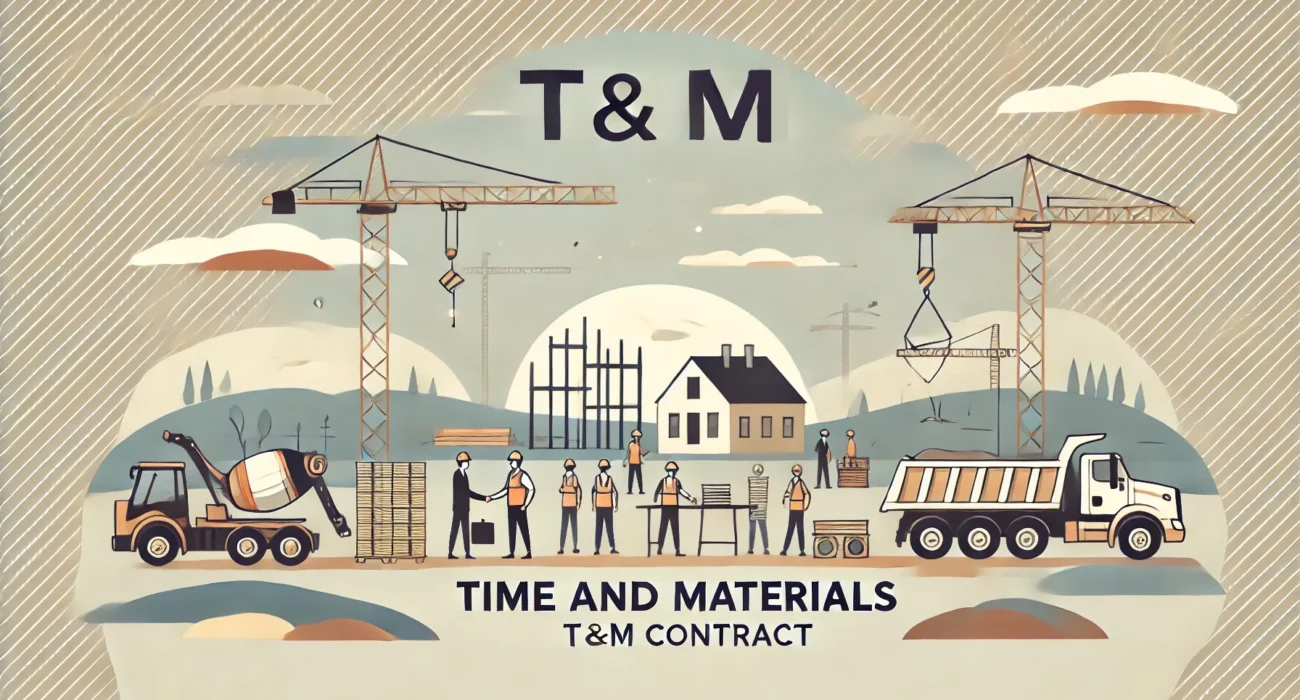Last Updated: February 27, 2025
Managing project agreements can be difficult, especially when dealing with unpredictable timelines or costs. For dynamic projects where flexibility is crucial, a Time and Materials (T&M) Contract offers a practical solution.
According to the Federal Acquisition Regulation (FAR) 16.601, T&M contracts are structured to clearly define billing for labor and materials, providing a flexible yet accountable approach for both project owners and contractors.
This blog discusses the basics of T&M contracts, including what they are, how they function, and their advantages and disadvantages from both perspectives.
What is a Time and Materials (T&M) Contract?
A Time and Materials (T&M) Contract is a type of agreement where clients pay for the actual time spent working and the materials used in completing a project. Unlike fixed-price contracts, this approach is ideal for projects with uncertain or evolving scopes.
With T&M contracts, labor costs are calculated based on an agreed-upon hourly or daily rate, while material costs are reimbursed according to actual expenses. This structure ensures both flexibility and accountability, enabling adjustments as project requirements change.
How Do Time and Materials Contracts Work?

Time and Materials (T&M) contracts are a flexible solution for projects where costs and timelines are uncertain. These agreements allow clients to pay for actual hours worked and materials used, ensuring fair reimbursement for contractors while maintaining clear and transparent billing practices.
In this type of contract, contractors bill for labor and materials, often including an agreed-upon markup. Materials costs encompass the purchase price, taxes, and shipping fees, while labor costs are based on a fixed hourly or daily rate that includes wages, overhead, and profit. This detailed approach ensures accountability and clarity in every stage of the project.
However, T&M contracts don’t imply an open-ended budget. Most agreements include an initial estimate based on the known project scope, often paired with a “not-to-exceed” clause. This clause sets a maximum budget, giving clients confidence in cost management while guiding contractors to stay within financial limits.
To see this in action, imagine a bakery renovation project. A bakery owner hires a contractor to repaint walls, install shelves, and upgrade countertops. During the work, the contractor discovers outdated plumbing that doesn’t meet safety standards and needs immediate replacement.
Thanks to the flexibility of the T&M contract, the contractor proceeds without renegotiating terms. They calculate the additional labor required at the agreed hourly rate, purchase new plumbing materials with a markup, and document all costs. At the week’s end, the contractor provides a detailed invoice, including labor hours, material expenses, and markup.
The bakery owner benefits from this approach, knowing they’re paying only for necessary work and materials. By the project’s end, the bakery achieves its vision of a cozier atmosphere, complete with modern plumbing, all without delays or financial surprises.
Key Components of T&M Contracts:
- Materials Costs: Includes the price of materials, taxes, shipping, and a markup (usually 10–30%).
- Labor Costs: Based on a fixed hourly or daily rate, covering wages, overhead, and profit.
- Adjustable Estimates: Contractors provide updated costs as project conditions evolve.
Why Choose T&M Contracts?
T&M contracts are perfect for projects where the scope or timeline is uncertain and likely to change. They are commonly used in fields like construction, IT, and consulting, where flexibility is essential.
Unlike lump sum contracts, which have a set price for well-defined projects, T&M contracts let both clients and contractors adjust to changes without being locked into a fixed cost. This makes them a great option for projects that evolve over time.
Learn more: Construction Contracts: 6 Key Types, Clauses, and Tips for 2024
Pros of Time and Materials (T&M) Contracts
T&M contracts benefit both project owners and contractors.
| Project Owners | Contractors |
|---|---|
| Flexibility to Adapt Owners can adjust the project scope as new needs arise without renegotiating terms. | Fair Compensation Contractors are paid accurately for their time and resources. |
| Transparency in Costs Detailed billing ensures owners know exactly where their money is going. | Simplified Planning No need to calculate a precise fixed cost for the entire project upfront. |
| High-Quality Results Focus remains on achieving the best outcomes rather than cutting costs to fit a rigid budget. | Adaptability Easier to accommodate unforeseen challenges or changes. |
| Faster Project Initiation Work can begin quickly without requiring exhaustive initial estimates. | Reduced Financial Risk Contractors aren’t responsible for absorbing unexpected costs. |
Cons of Time and Materials (T&M) Contracts
While a Time and Materials (T&M) contract provides many benefits, it also comes with certain challenges for both parties. To minimize potential drawbacks, it is crucial to establish a clear, detailed contract, encourage strong collaboration, and prioritize open, transparent communication throughout the project.
| Project Owners | Contractors |
|---|---|
| Uncertain Final Costs Without a predefined budget, expenses can be difficult to predict. | Administrative Burden Requires meticulous tracking of labor hours and materials used. |
| Risk of Cost Overruns Unexpected developments may lead to higher bills than anticipated. | Potential Client Scrutiny Clients may frequently review and question invoices or progress. |
| Increased Monitoring Owners need to closely track invoices and project progress to ensure accuracy. | Uncertain Project Timelines Prolonged projects can complicate resource scheduling for other jobs. |
Making the Most of Time and Materials Contracts
Time and Materials (T&M) contracts are great for projects that change over time, but they do require careful tracking and clear communication to avoid unexpected costs. With the right approach, both clients and contractors can keep the project on track and prevent surprises.
Builtfront makes managing T&M contracts easier by offering the tools you need to stay organized and keep projects running smoothly.
Start your free trial today and see how Builtfront can help you manage your contracts with confidence.

